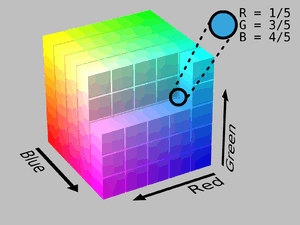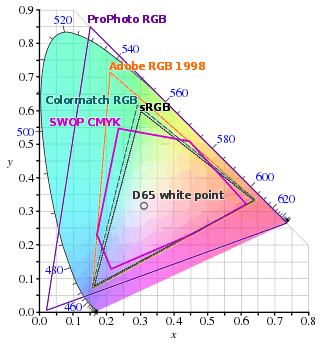RGB color space
An RGB color space is any additive color space based on the RGB color model.[1][2] A particular color space that employs RGB primaries for part of its specification is defined by the three chromaticities of the red, green, and blue additive primaries, and can produce any chromaticity that is the 2D triangle defined by those primary colors (ie. excluding transfer function, white point, etc.).[3] The primary colors are specified in terms of their CIE 1931 color space chromaticity coordinates (x,y), linking them to human-visible color.

RGB is an abbreviation for red–green–blue.
Intuition

An RGB color can be understood by thinking of it as all possible colors that can be made from three colored lights for red, green, and blue. Imagine, for example, shining three lights together onto a white wall in a dark room: one red light, one green light, and one blue light, each with dimmers. If only the red light is on, the wall will be red. If only the green light is on, the wall will look green. If the red and green lights are on together, the wall will look yellow. Dim the red light and the wall will become more of a yellow-green. Dim the green light instead, and the wall will become more orange. Bringing up the blue light a bit will cause the orange to become less saturated and more whitish. In all, each setting of the three dimmers will produce a different result, either in color or in brightness or both. The set of all possible results is the gamut defined by those particular color lamps. Swap the red lamp for one of a different brand that is slightly more orange, and there will be a slightly different gamut, since the set of all colors that can be produced with the three lights will be changed.
Applications
A computer LCD display can be thought of as a grid of millions of little red, green, and blue lamps, each with their own dimmers. The gamut of the display will depend on the three colors used for the red, green, and blue lights, their pattern of organisation, and their luminance when on.
Some color spaces defined for this purpose with RGB primaries are sRGB and Adobe RGB (which has a significantly larger gamut). Adobe has recently developed another color space called Adobe Wide Gamut RGB, which is even larger, in detriment to gamut density.
As of 2007, sRGB is by far the most commonly used color space for computer displays. HDTVs use a similar space, commonly called Rec. 709, sharing the sRGB primaries. The sRGB space is considered adequate for most consumer applications. Having all devices use the same color space is convenient in that an image does not need to be converted from one color space to another before being displayed. However, sRGB's limited gamut leaves out many highly saturated colors that can be produced by printers or in film, and thus is not ideal for some high quality applications.
Specifications with RGB primaries
| Color space | Standard | Year | Gamut | White point | Primaries | Transfer function parameters | |||||||||
|---|---|---|---|---|---|---|---|---|---|---|---|---|---|---|---|
| Red | Green | Blue | α | β | γ | δ | βδ | ||||||||
| xʀ | yʀ | xɢ | yɢ | xʙ | yʙ | a + 1 | K₀/φ = Et | φ | K₀ | ||||||
| ISO RGB | Limited | floating | floating | ||||||||||||
| Extended ISO RGB | Unlimited (signed) | ||||||||||||||
| scRGB | IEC 61966-2-2 | 2003 | D65 | 0.64 | 0.33 | 0.30 | 0.60 | 0.15 | 0.06 | ||||||
| sRGB | IEC 61966-2-1 | 1990, 1996 | CRT | 1.055 | 0.0031308 | 12/5 | 12.92 | 0.04045 | |||||||
| HDTV | ITU-R BT.709 | 1999 | 1.099 | 0.004 | 20/9 | 4.5 | 0.018 | ||||||||
| Adobe RGB 98 | 1998 | 0.21 | 0.71 | 1 | 0 | 563/256 | 1 | 0 | |||||||
| PAL / SECAM | EBU 3213-E, ITU-R BT.470/601 (B/G) | 1970 | 0.29 | 0.60 | 1 | 0 | 14/5 | 1 | 0 | ||||||
| Apple RGB | 0.625 | 0.34 | 0.28 | 0.595 | 0.155 | 0.07 | |||||||||
| NTSC | SMPTE RP 145 (C), 170M, 240M | 1987 | 0.63 | 0.31 | 1.1115 | 0.0057 | 20/9 | 4 | 0.0228 | ||||||
| NTSC-J | 1987 | D93 | |||||||||||||
| NTSC (FCC) | ITU-R BT.470/601 (M) | 1953 | C | 0.67 | 0.33 | 0.21 | 0.71 | 0.14 | 0.08 | 1 | 0 | 11/5 | 1 | 0 | |
| eciRGB | ISO 22028-4 | 1999 (v1), 2007, 2012 | Wide | D50 | 1.16 | 0.008856 | 3 | 9.033 | 0.08 | ||||||
| DCI-P3 | SMPTE RP 431-2 | 2011 | Theater | 0.68 | 0.32 | 0.265 | 0.69 | 0.15 | 0.06 | 1.055 | 0.0031308 | 12/5 | 12.92 | 0.04045 | |
| Display P3 | SMPTE EG 432-1 | 2010 | D65 | ||||||||||||
| UHDTV | ITU-R BT.2020, BT.2100 | 2012, 2016 | 0.708 | 0.292 | 0.170 | 0.797 | 0.131 | 0.046 | 1.0993 | 0.018054 | 4.5 | 0.081243 | |||
| Adobe Wide Gamut RGB | D50 | 0.735 | 0.265 | 0.115 | 0.826 | 0.157 | 0.018 | 1 | 0 | 563/256 | 1 | 0 | |||
| RIMM | ISO 22028-3 | 2006, 2012 | 0.7347 | 0.2653 | 0.1596 | 0.8404 | 0.0366 | 0.0001 | 1.099 | 0.0018 | 20/9 | 5.5 | 0.099 | ||
| ROMM RGB, ProPhoto RGB | ISO 22028-2 | 2006, 2013 | 1 | 0.001953125 | 9/5 | 16 | 0.031248 | ||||||||
| CIE RGB | 1931 | E | 0.2738 | 0.7174 | 0.1666 | 0.0089 | |||||||||
| CIE XYZ | 1931 | Unlimited | 1 | 0 | 0 | 1 | 0 | 0 | 1 | 0 | 1 | 1 | 0 | ||
See also
- CIE L*a*b* color space
- Web colors
- RGB color model
- RGBA color model
References
- Saini, Harvinder Singh; Sayal, Rishi; Buyya, Rajkumar; Aliseri, Govardhan (2020). Innovations in Computer Science and Engineering. Singapore: Springer Singapore. p. 235. ISBN 9789811520433.
- Poynton, Charles A. (2003). Digital Video and HDTV: Algorithms and Interfaces. Morgan Kaufmann. ISBN 1-55860-792-7.
- Hunt, R. W. G (2004). The Reproduction of Colour (6th ed.). Chichester UK: Wiley–IS&T Series in Imaging Science and Technology. ISBN 0-470-02425-9.
External links
- Pascale, Danny. "A Review of RGB color spaces...from xyY to R'G'B'" (PDF). Retrieved 2008-01-21.
- Susstrunk, Buckley and Swen. "Standard RGB Color Spaces" (PDF). Retrieved November 18, 2005.
- Lindbloom, Bruce. "RGB Working Space Information". Retrieved November 18, 2005.
- Colantoni, Philippe. "RGB cube transformation in different color spaces". Archived from the original on 2008-05-05.